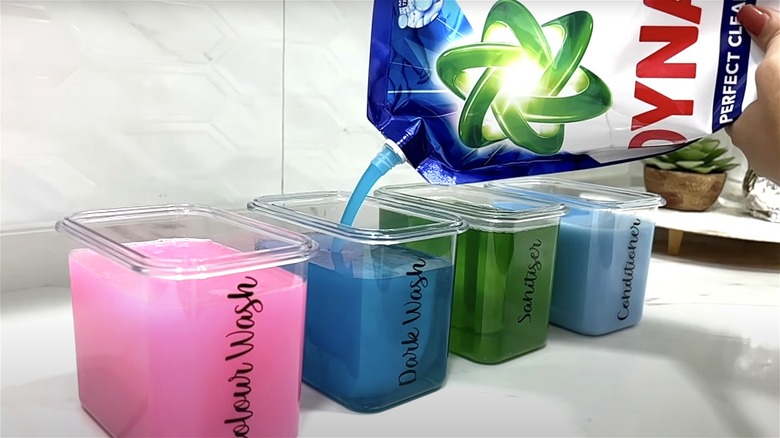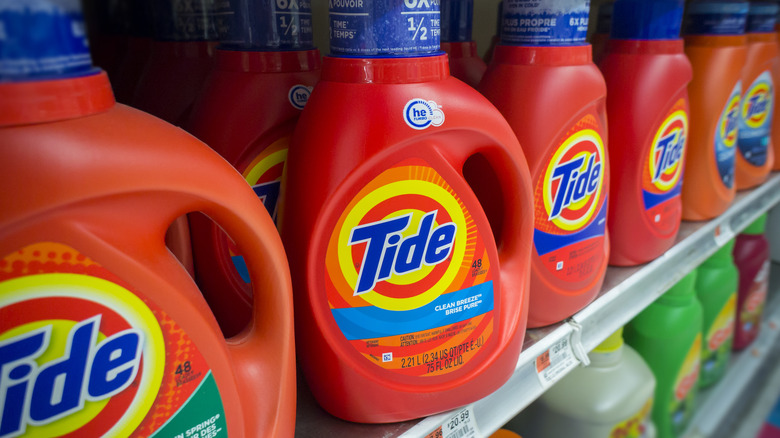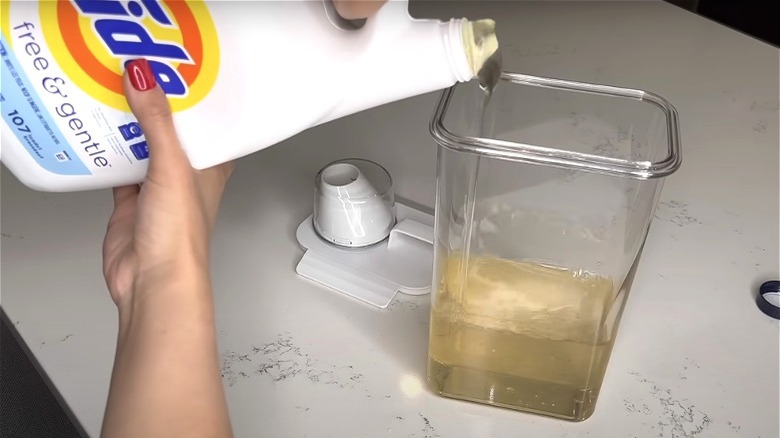No, You Don't Need To Put Your Laundry Detergent In A Cute Container (It Could Also Be Dangerous)
Because we use a lot of household cleaners, we often buy them in big containers. It's not just cheaper, but it also saves you from having to run to the store all the time and cuts down on the amount of plastic you bring home. However, having that big jug of laundry detergent can be difficult to handle, so you might be tempted to transfer the liquid to a smaller, cuter container. Not only does this help maintain organization, but it also saves space and reduces clutter in your laundry room. In fact, you'll see a lot of laundry room makeovers on social media doing just that — ditching bulky containers for neat, labeled ones. However, moving products out of their original containers can lead to losing important safety information, which is both inconvenient and potentially unsafe.
Whether it's for ease of use or you just see organizing bottles of various heights, colors, and shapes as a hassle, transferring laundry detergents and other home cleaning products into new containers might seem like a good idea. However, discarding the original packaging can be risky, particularly for households with children unaware of the contents.
Why discarding original containers isn't a great idea
It's important to remember that household cleaners are potentially dangerous chemicals. Companies include many details on labels to keep consumers safe. So, when you discard the original packaging, you lose access to these essential details. Labels typically contain directions on proper product usage. For instance, some chemicals work well for particular situations but can be caustic or damaging in other cases. Cleaner containers also typically include a caution section on their labels, which offers critical information about the product's potential health and safety hazards. It might instruct you to use the product in a well-ventilated area and to keep it away from your hands and mouth. Additionally, the label may remind you to wear protective equipment like masks and gloves when handling the product.
Aside from these, many product labels also include first aid advice, like what to do if the product accidentally gets into eyes or swallowed. While you can probably find a label online with a quick search, having it readily available, especially in an emergency, allows you to take immediate action. The label includes vital disposal and storage instructions to guide you on the right way to dispose of the cleaning product, whether their containers can be reused, and when you should throw your cleaning product containers away. Additionally, you may find certification symbols — related to causes like sustainability and animal testing, for example — on the label that help you determine if the product meets your values and priorities.
More dangers of transferring laundry detergents into other containers
Laundry detergents often come in vibrant colors, and when you pour them into clear containers, they can look appealing. Add in the fruity scents, and it's easy to see why kids might think they've stumbled upon a delicious drink. For instance, look at this laundry restock video on TikTok — it's pretty easy to mistake those pods and scent boosters with yummy treats. In fact, household cleaning products are the second leading cause of accidental poisoning among children under 6 in the U.S. Additionally, unintentional poisonings reportedly cause 240 deaths and nearly 4,900 emergency room visits every day.
It's common to transfer household cleaners into clear, aesthetically pleasing containers, and you might even find yourself wanting to repurpose your empty favorite laundry detergent bottles. However, this practice can lead to incorrect or even dangerous usage of the product. Plus, the container you choose might not be suitable for the chemical it ends up holding, which can be a safety hazard. If you suspect a poisoning has occurred, go to poisonhelp.org or call the National Poison Help Line (1-800-222-1222).


